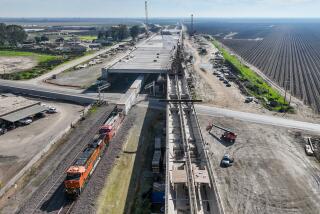Brown wants China aboard California’s high-speed rail project
SHANGHAI — Gov. Jerry Brown’s trade mission to China this week is intersecting with one of the most controversial issues of his governorship: California’s $68-billion bullet train.
The governor has staked part of his legacy on the rail network, a centerpiece of his vision for California. He is hoping that China, which is enjoying an economic boom and spent $77.6 billion on overseas investments last year, according to official figures, will pump some of its cash into the troubled project.
Brown’s top economic advisor and rail commission appointee, Mike Rossi, met in Beijing with Chinese investors eager for an update on its progress. And China’s vice minister of commerce told a hotel ballroom packed with California government and business officials that his country wanted to explore “the possibility of investment in the high-speed rail project in California.”
A few potential vendors have already expressed interest. California rail board chief Dan Richard is set to meet Saturday with the China Railway Construction Corp., the country’s second-largest government-owned construction concern.
On Thursday evening, Brown, Richard and representatives of California-based railroad companies rode China’s sleek bullet train to this bustling port city from Beijing, a five-hour trip that covered about 750 miles, roughly the distance from San Diego to the Oregon border. Strolling the aisles, shaking hands with Chinese passengers, Brown extolled the nation’s 5,000-mile complex of high-speed rail, built in the last seven years.
“People here do stuff,” the governor said. “They don’t sit around and mope and process and navel-gaze. The rest of the world is moving at Mach speed.”
The Chinese interest in California’s project is a welcome boost for Brown. Although state voters approved $10 billion in bonds for a high-speed railway in 2008, they have soured on it as cost estimates have ballooned by tens of billions of dollars. The governor, who has vowed repeatedly to see the train system built, needs at least an additional $55 billion to make it happen.
Republicans in Congress have threatened to cut off funding from Washington, saying the bullet train is unnecessary and too costly. Much of the money will have to come from elsewhere.
“We are very interested in California,” said rail car designer and engineer Jiang Lay, as the train to Shanghai zoomed along Thursday, without the jerky stops familiar to Amtrak riders. His company, Tangshan Vehicle Co., built the model Brown was riding. “We are very confident that our Chinese technology can be successful in America,” he said.
The firm has formed a partnership with a U.S.-based company, Sun Group USA, to compete for California business. The company, which has significant Chinese financing, is exploring construction of a plant in Oakland.
California officials and the Chinese government have already made preliminary agreements to work together on construction of the bullet train,
State leaders, in fact, have long been laying the foundation for Chinese investment. In 2010, Gov. Arnold Schwarzenegger led a delegation to Shanghai, where California’s rail chief held discussions with leaders of the China Investment Corp.
The state-owned company has assets worth an estimated $480 billion, according to the Las Vegas-based Sovereign Wealth Fund Institute, which monitors large global investors.
Participants in the 2010 meetings said China was represented in some discussions by Kathleen Brown, sister of the current governor, who ran the West Coast municipal finance team for Goldman Sachs. No deals were inked, but nearly three years after those meetings, transportation officials in California say they now have a more compelling story to tell the Chinese.
The federal government has chipped in $3 billion for the project, and last year state lawmakers approved the sale of $4.5 billion in bonds to help fund the first stage of construction. This summer, work is set to begin on the first segment of the network, which will connect the Central Valley towns of Madera and Bakersfield.
Plans call for the train to reach the San Fernando Valley by 2022.
Still, “there will probably have to be more up-front investment from the state before they get to the point where it’s really ripe for Chinese or any other outside investment,” said Sean Randolph, president of the Bay Area Council Economic Institute, part of the group that organized the China trip for Brown and dozens of California business and political leaders.
“A lot of progress has been made over the last three years,” Randolph said, but the project is “still speculative.”
Brown’s traveling party boarded the Chinese train, named Harmony, Thursday after a private meeting with Chinese Premier Li Keqiang. Earlier in the day, the governor had addressed Chinese officials, academics and others at prestigious Tsinghua University, pressing for policies that limit greenhouse gas emissions. On Wednesday, he and Chinese leaders signed environmental cooperation agreements.
As the train raced through the Chinese countryside, a digital speedometer flashed speeds of 180 mph in the first-class cabin where Brown and his wife, Anne Gust Brown, had seats. Attendants offered snacks of salted dried plums and wasabi-coated peas.
The governor had plenty of reading material for the journey: a copy of China’s five-year plan.
More to Read
Sign up for Essential California
The most important California stories and recommendations in your inbox every morning.
You may occasionally receive promotional content from the Los Angeles Times.









